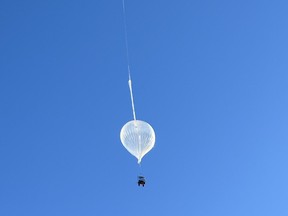Quantum-level imperfections in synthetic diamonds could be used to develop the next generation of magnetic field maps.

Article content
A Sherbrooke company is betting that quantum-level imperfections in synthetic diamonds are the key to mapping the world’s magnetic field, a technology that could open the door to better navigation tools and make it easier to search for critical minerals on Earth, the moon and Mars.
SBQuantum said it’s taking another step toward putting its quantum magnetometers into space as it announced contracts with the European Space Agency and the Canadian Space Agency on Tuesday.
Advertisement 2
Story continues below
Article content
“For me, as a founder, it’s really great validation. It’s great after all these years of developing the technology, seeing that we’re at the forefront and we’re kind of the first choice for these companies,” said David Roy-Guay, the company’s CEO and co-founder, who began working on the technology while he was doing his PhD in quantum physics.
SBQuantum wants its sensors to be used to develop the next generation of magnetic field maps — a crucial technology for cellphone navigation applications, which compare the cellphone’s internal compass with magnetic field maps to figure out which direction the phone is facing — and allow space agencies to replace aging bus-sized satellites with tiny satellites — called “cubesats” — the size of a jug of milk.
The contract with the ESA comes after the agency issued an open call for companies developing the quantum diamond technology, which the agency wants to test, and selected SBQuantum.

Being selected by the ESA is a sign SBQuantum has become a global leader in its field, said Roy-Guay. The ESA is looking at how the technology can enable smaller satellites, or be placed on moon or Mars rovers, where they would be used to navigate, or to look for ore deposits.
Article content
Advertisement 3
Story continues below
Article content
“Their objective is looking at how this technology can suit scientific mission purposes and be used in the future,” he said.
The ESA contract is also helping the company continue its research and development, said Emily Santilli, the company’s senior product manager.
The technology works by replacing a carbon atom inside the synthetic diamond with a nitrogen atom, that frees up electrons, whose quantum spin makes a tiny magnet, which is used to measure the direction of the magnetic field. The data is gathered by shining a laser on the diamond, the light emitted by the diamond then provides information on the magnetic field and its intensity.
Roy-Guay said SBQuantum has also had to learn to correct for other magnetic objects in the environment. In the company’s office, he said, if a truck carrying a steel bar drives by, that will show up on the sensor. In order to get the technology ready for space, computer programs had to be developed to compensate for the metal in the satellites themselves.
One of the advantages the quantum sensor technology is that “you can see really far and through anything, nothing obstructs it, it has a lot of benefits” said Santilli. “But that’s also one of the challenges to analyzing the results: you see everything.”
Advertisement 4
Story continues below
Article content
To develop software to correct for that, she said, the company has been testing the sensor in a range of different environments.
The company’s contract with the Canadian Space Agency saw the sensor launched into the stratosphere in a high-altitude balloon.

During that test in May, the sensor spent around 12 hours at an altitude of 40 km — almost four times as high as the cruising altitude of a long-haul commercial plane — testing the magnetometer’s resilience to the shock of a rocket launch and a rough landing, as well as its ability to collect precise data in temperatures as low as -60 C and under lower pressure and higher radiation exposure than on Earth.
Roy-Guay said the technology worked flawlessly and data gathered during the test will help his company develop navigation systems that don’t use GPS.
“In cases where there’s no GPS, like underground, or underwater, in conflict zones, even in northern Canada where the quality of the GPS might be degraded, there is the potential to use the Earth’s magnetic field, mainly the magnetic field from the crust of the Earth, in order to to perform high-precision navigation,” he said.
At the same time, SBQuantum is preparing for a 2026 space launch as part of the MagQuest Challenge, a contest organized by the U.S. Department of Defence’s National Geospatial-Intelligence Agency and NASA.
SBQuantum is currently one of three finalists in that challenge, which also aims to develop small, cheaper satellites to map the Earth’s magnetic field.
Recommended from Editorial
Advertisement 5
Story continues below
Article content
Article content


Comments